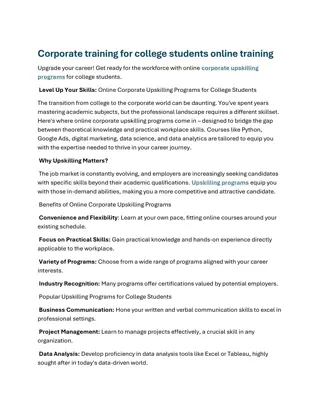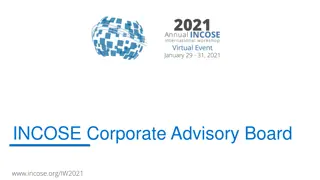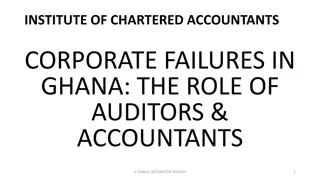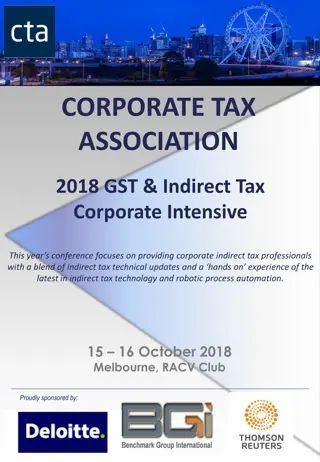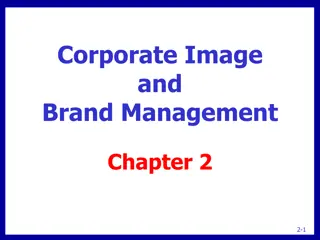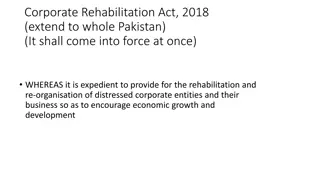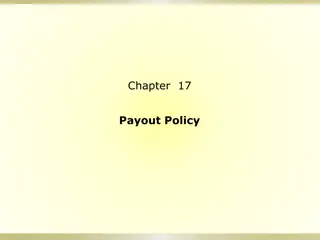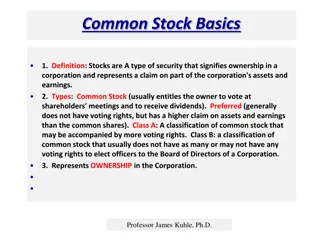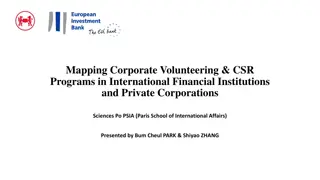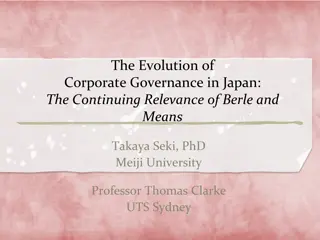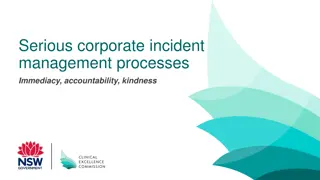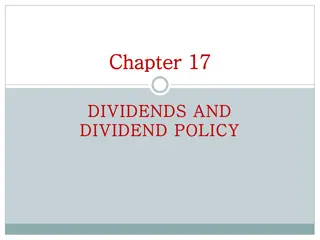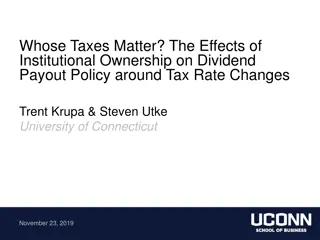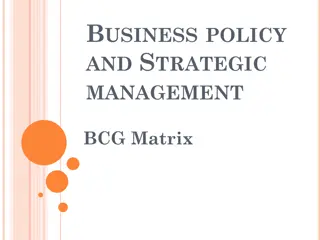Understanding Market Structure and Corporate Payout Policy
This research paper examines the relationship between market structure and corporate payout policy, focusing on dividends and share repurchases. It addresses key puzzles in the payout literature, highlighting the impact of market frictions on dividend payments and the rise of share repurchases. The study delves into the costs associated with different market structures and how changes in the market environment influence corporate payout decisions. Additionally, it discusses event studies and a controlled experiment related to the Manning Rule in 1994, which affected the execution priority for issuers in NASDAQ.
Download Presentation

Please find below an Image/Link to download the presentation.
The content on the website is provided AS IS for your information and personal use only. It may not be sold, licensed, or shared on other websites without obtaining consent from the author. Download presentation by click this link. If you encounter any issues during the download, it is possible that the publisher has removed the file from their server.
E N D
Presentation Transcript
Market Structure and Corporate Payout Policy Xiongshi Li Guangxi University Mao Ye University of Illinois at Urbana-Champaign and NBER Miles Zheng University of Illinois at Urbana-Champaign The Microstructure Exchange June 23, 2020
Two Famous Puzzles in the Payout Literature Two forms of corporate payouts: dividends and share repurchases Miller and Modigliani (1961): paying out through dividends or share repurchases does not matter Tax disadvantages of dividends Dividend tax was higher than capital gain tax Capital gain tax can be deferred Two most salient puzzles (Farre-Mensa, Michaely, and Schmalz 2014) Dividend puzzle (Black 1976) Why do firms pay dividend at all? Secular increase of share repurchases relative to dividends over the past three decades This paper: the costs of repurchases can address these two puzzles simultaneously Market structure frictions can explain why repurchases cannot completely drive out dividends The reduction in market structure frictions over time explains the secular increase in share repurchases
Costs under Old vs. New Market Structures Liquidity cost Firms and their investors pay transaction costs Compliance cost: SEC rule 10b-18 Repurchase price should not exceed the highest bid or previous trade price Prevent firms from inflating their stock price by demanding liquidity at the ask price Dealer market modeled by Ho and Stoll (1981) and Glosten and Milgrom (1985) Firms cannot buy at the bid price, because buy orders are executed at the ask price Firms cannot buy at a price less or equal to the previous price The move towards electronic limit order books and dark pools reduces these frictions Limit order books: firms can submit limit orders at the bid price Dark pools: firms can match their orders passively at the bid price
Event Studies and a Controlled Experiment The 1994 Manning Rule: Increase execution priority for issuers Prior to 1994, NASDAQ dealers can trade ahead of issuers at the same price Example: a dealer quotes $100 bid and $102 ask, and an issuer quotes $100 bid The issuer s quote only entitled to an execution when the market ask price drop to $100 Higher execution costs for issuers Violates SEC 10b-18 because the execution is at the ask The Manning Rule prohibits dealers from executing ahead of their customers at the same price Share repurchases of NASDAQ firms increase by 69% relative to non-NASDAQ firms Tick size reduction from $1/8 to $1/16 in 1997 and then to 1 cent in 2001 Reduce the depth, or the queue to provide liquidity at the same price Share repurchase increased by 68% and 32% (stocks with larger vs smaller change in bid-ask spread) NYSE installed autoquotes in 2003 Computer algorithms reduce both execution and compliance costs NYSE firms increased their share repurchase by 24% relative to non-NYSE firms
Event Studies and a Controlled Experiment In 2016, SEC randomly selected 1200 stocks and increases their tick size to 5 cents Tick size for 1199 control stocks remains at 1 cent Repurchase payouts for treatment firms decrease by 21% The reduction is as high as 45% if the stocks bid-ask spreads are less than 5 cents before treatment Tick-constrained treatment firms 400 stocks in test group 3 suffer from additional treatment: trade-at requirement Dark pools need to execute a trades at a price 2.5 cents higher than the highest displayed bid price At the same price, trade-at rule grants execution priority to displayed orders in exchanges SEC 10b-18: repurchase price should be less than or equal to the highest displayed bid price Unintended contradictions between two rules implicitly ban share repurchases in dark pools Tick-constrained firms in test group 3 reduce share repurchases by 55% Tick-constrained firms in test groups 1 & 2 reduce share repurchases by 36%
Roadmap The controlled experiment: tick size pilot Tick size: constrained firms in test groups reduce their repurchase payouts by 45% Time priority: constrained firms with larger increase in bid-depth reduce repurchases more Dark pool: constrained firms in test group 3 reduce repurchases by 55% Event studies 1994 Manning Rule Higher execution priority for NASDAQ issuers increases share repurchases by 69% Two tick size reductions Reduction in queue length at the same price increases share repurchases by 68% after 1997 and 32% after 2001 Installation of autoquotes for NYSE The move from manual to automatic trading increases share repurchases by 24%
Roadmap The controlled experiment: tick size pilot Tick size: constrained firms in test groups reduce their repurchase payouts by 45% Time priority: constrained firms with larger increase in bid-depth reduce repurchases more Dark pool: constrained firms in test group 3 reduce repurchases by 55% Event studies 1994 Manning Rule Higher execution priority for NASDAQ issuers increases share repurchases by 69% Two tick size reductions Reduction in queue length at the same price increases share repurchases by 68% after 1997 and 32% after 2001 Installation of autoquotes for NYSE The move from manual to automatic trading increases share repurchases by 24%
Sample Stocks Start in the universe of Reg NMS securities in April 4, 2016 Market cap < $3 billion, price higher than $2 on the last day of the measurement period Price > $1.5 every day, average daily volume < 1 million shares during the measurement period Result: 2,399 stocks Stratified random sampling of 27 buckets (3-by-3-by-3 independent sorting) Share price, market cap, and trading volume Low, medium, and high: each has one-third of the population Final list: 1200 treatment stocks and 1199 control stocks
Four Groups Compare three test groups with control group to evaluate the overall impact Compare test group 3 and test groups 1&2 to evaluate the impact of dark trading
Methodology: Difference-in-Differences Tests ??,?= ??+ ??+ ? ?????????? ?????+ ? ??,?+ ??,? ??,?: payout variables and market liquidity variables ??: firm fixed effects ??: year-quarter fixed effects. ??????????: equals 1 if a firm is in a test group and 0 if it is in the control group ?????: 1 for quarters in the pilot period (2016 Q4 2018 Q3) and 0 for quarters in 2014 Q4 2016 Q3 ??,?: control variables (Fama and French 2001) Size, profitability, and growth opportunities (Market-to-book)
Firms Reduce Repurchase Payouts by 21% The reduction in repurchase payouts is 0.09% over total assets per quarter Average repurchase payout before the pilot was 0.43%
Total Payouts and Structure of Payouts Total payouts decrease by 14% (average repurchase payout before the pilot was 0.67%) Payout structure (repurchase payouts +1)/(dividend payouts +1) decreases by 0.08
Tick-Constrained vs. Unconstrained Samples Constrained firms in the treatment group reduce repurchase payouts by 0.18% Average repurchase payout before the pilot was 0.41% A decline of 45% compared with the pre-shock level
Puzzle Why is the effect so large? Firms can still finish repurchase by paying a few more cents per share if they can use market orders The compliance channel: SEC Rule 10b-18 Purpose: prevents corporations from manipulating prices Four safe-harbor conditions Price: repurchase price should not exceed the highest bid or previous trade price Encourage firms to provide liquidity when repurchasing shares Volume: The issuer cannot purchase over 25 percent of the average daily volume in the preceding four weeks Timing: The issuer cannot trade at the opening or during the last 30 minutes of trading Manner: The issuer must purchase all shares from a single broker or deal during a single day
Price Conditions Under Modern Market Structure Issuers repurchasing at a price exceeding the highest bid are subject to manipulation suspicion HFT: $5.03 Repurchase broker: $5.02 Best Ask $5.01 If I use a market order, it will be executed immediately. $5.00 Repurchase brokers are generally slower than HFTs If a firm hires an HFT as its broker, the HFT becomes slower than other HFTs because it must comply with 10b-18 $4.99 Best Bid $4.98 $4.97
Increase in Tick Size: Queuing On Bid-Side Tick Size Pilot Program HFT: $5.00 Repurchase brokers: $4.99 Wait for execution I will use a limit order $4.98 $4.97 $4.96 $4.95 Queuing (lower and lower priority)
A Large Increase in Bid-Side Depth Reduces Repurchases Cutoff: the median value
Summary Greater depth is generally considered more liquid (Goldstein and Kavajecz 2000) However, a market with large depth on the bid side may imply an illiquid market for issuers
Dark Pool Matters for Share Repurchases Tick-constrained firms in test group 3 reduce share repurchases by 55% Tick-constrained firms in test groups 1 & 2 reduce repurchases by only 36% Modest difference in change in liquidity (Rindi and Werner 2019)
Test Group 1&2 Issuers: Queue-Jumping Using Dark Pools Tick Size Pilot Program HFT: $5.00 Repurchase brokers: Send orders to dark pools to jump ahead of the long queue $4.95 Queuing (lower and lower priority)
Test Group 3 Issuers: Conflict Between New and Old Rules Tick Size Pilot Program HFT: $5.00 Repurchase brokers: New trade-at rule for test group 3 (purpose: improve trading transparency): Orders in dark pools have to improve the price in the stock exchange by more than 2.5 cents the bid price in the stock exchange Old rule 10b-18 price condition (purpose: prevent price manipulation): Repurchasing price should not be higher than Face double constraints in both exchanges and dark pools: fail to execute Not available for repurchasing orders $4.95 Queuing (lower and lower priority)
Intuition Non-price competition under price controls Kornai (1980) and Shleifer and Vishny (1992a and 1992b) Queuing: arrive at the market earlier to beat rivals High-frequency trading is an application Dark market or side payments The dark pool is an application Firms pay dark pool to find trading counterparties Dark pool then can pay for order flow to the counterparties
Similar Results Among Large and Small firms Partition based on total assets For small firms, tick-constrained firms reduce share repurchases by 46% (0.155%/0.335%) For large firms, tick-constrained firms reduce share repurchases by 45% (0.220%/0.490%)
Reversal Test Tick size pilot ends on Oct. 1, 2018 Tick-constrained firms increase their repurchases after pilot ends 45% increase (0.122/0.304)
Roadmap The controlled experiment: tick size pilot Tick size: constrained firms in test groups reduce their repurchase payouts by 45% Time priority: constrained firms with larger increase in bid-depth reduce repurchases more Dark pool: constrained firms in test group 3 reduce repurchases by 55% Event studies 1994 Manning Rule Higher execution priority for NASDAQ issuers increases share repurchases by 69% Two tick size reductions Reduction in queue length at the same price increases share repurchases by 68% after 1997 and 32% after 2001 Installation of autoquotes for NYSE The move from manual to automatic trading increases share repurchases by 24%
1994 NASDAQ Manning Rule Tick Size Pilot: Longer queue harms share repurchases Issuers may not win time priority over professional liquidity providers Market makers decades ago Enjoy much more priorities than HFTs today Before 1994 Manning Rule, a NASDAQ dealer can trade ahead of their customers even if their customers submit the order earlier (Hasbrouck, 2007) 1994 Manning rule Prohibits dealers from trading before customers at the same price Makes it easier for issuers to execute their limit orders at the bid price ??,?= ??+ ??+ ? ?????????? ?????+ ? ??,?+ ??,? ??????????: NASDAQ firms vs. matched non-NASDAQ firms ?????: 1995 vs. ????: 1993 (annual data)
1994 NASDAQ Manning Rule NASDAQ firms relative to other firms Repurchase payouts increases by 69% (0.42%/0.61%)
Roadmap The controlled experiment: tick size pilot Tick size: constrained firms in test groups reduce their repurchase payouts by 45% Time priority: constrained firms with larger increase in bid-depth reduce repurchases more Dark pool: constrained firms in test group 3 reduce repurchases by 55% Event studies 1994 Manning Rule Higher execution priority for NASDAQ issuers increases share repurchases by 69% Two tick size reductions Reduction in queue length at the same price increases share repurchases by 68% after 1997 and 32% after 2001 Installation of autoquotes for NYSE The move from manual to automatic trading increases share repurchases by 24%
1997 Tick Size Reduction and 2001 Decimalization In 1997, tick size decreases from $1/8 (12.50 cents) to $1/16 (6.25 cents) Treatment group: firms with above median reductions in quoted spread Control group: firms with below median reductions in quoted spread (matched sample) Fang, Tian, and Tice (2014) ?????: 1998 vs. ????: 1996 (annual data) In 2001, tick size decreases from $1/16 (6.25 cents) to 1 cent ?????: 2002 vs. ????: 2000 (annual data)
Tick Size Reduction Leads to More Share Repurchases Treatment firms relative to control firms 1997 tick size reduction: repurchase payouts increases by 68% (0.58%/0.85%) 2001 decimalization: repurchase payouts increases by 32% (0.57%/1.75%)
Roadmap The controlled experiment: tick size pilot Tick size: constrained firms in test groups reduce their repurchase payouts by 45% Time priority: constrained firms with larger increase in bid-depth reduce repurchases more Dark pool: constrained firms in test group 3 reduce repurchases by 55% Event studies 1994 Manning Rule Higher execution priority for NASDAQ issuers increases share repurchases by 69% Two tick size reductions Reduction in queue length at the same price increases share repurchases by 68% after 1997 and 32% after 2001 Installation of autoquotes for NYSE The move from manual to automatic trading increases share repurchases by 24%
Dividend Tax Cut & Reduced Frictions of Share Repurchase in 2003 Relative taxation advantage: 2003 dividend tax cut increases dividend payouts Puzzle: repurchase payouts increases even more (Chetty and Saez, 2005; 2006) A reduction in dividend tax should increase dividend relative to share repurchase Understanding the microeconomic foundations of the cost of share repurchases is of great importance for future work (Chetty and Saez, 2010) Our interpretation: computer algorithms reduce the cost of share repurchase Before 2003, specialists in NYSE manually disseminate the quotes. Manual execution of share repurchases (high touch) Costly Hard to comply with 10b-18 Auto quotes allow computer algorithms to execute share repurchases (low touch) Real-time feedback on market information Automatically submit orders
NYSE Autoquotes ??????????: NYSE firms vs. matched non-NYSE firms ?????: 2004 vs. ????: 2002 (annual data) Repurchase payouts of NYSE firms increase by 24% (0.41%/1.72%)
Conclusion Stock market structure has first-order effects on share repurchases The cost to comply with SEC 10b-18 is prohibitively high in a pure dealer market Market microstructure reforms since the 1990s reduce the privilege of professional market makers This trend of disintermediation reduces the frictions for issuers to buy back shares The cost of repurchases provides a unified explanation for two puzzles The reduction in these costs over time can explain why share repurchases increase more than dividends However, the liquidity and compliance costs always exist Provide an explanation on why share repurchases cannot completely drive out dividends
Two New Dimensions for Research on Liquidity Liquidity for whom Regulations change the definition of liquidity for distinct groups of traders A market with greater depth is generally considered a liquid market, but may be illiquid for repurchasing firms who face regulatory constraints Liquidity where Distribution of liquidity across distinct types of platforms is important Dark-pool liquidity matters for share repurchases Dark pools match orders based on the price set by the exchanges Their passive price determination dovetails nicely with the philosophy of SEC 10b-18 SEC (2010) even discussed the possibility to exempt dark pools from 10b-18 when dark pools match orders at the midpoint of bid and ask.
Policy Implications Market microstructure Conflicts between the old and new rules Rule 10b-18: repurchase price cannot exceed highest bid or previous trade prices Trade-at rule: prices in dark pool should be higher than the highest bid Regulators should examine whether proposed new regulations contradict with existing regulations More regulation vs. deregulation High-frequency trading and dark pools can be a response to existing regulations Share repurchases Heated debate on the secular increase of share buybacks and plans to ban share buybacks Limited economic analysis on why share repurchases increase over time Our paper provides one explanation
Secular Increase of Share Repurchases Relative to Dividends Click here to go back



